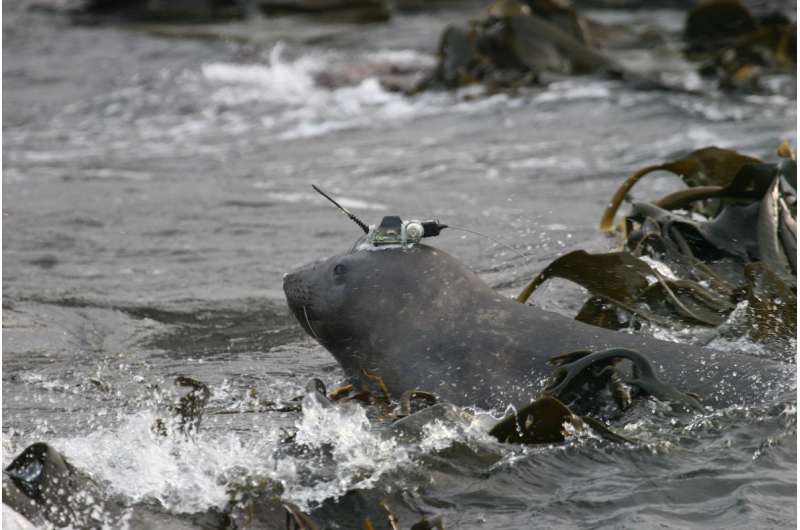Southern elephant seal fitted with a logger for recording diving data. Credit: Christophe Guinet
When southern elephant seals find dense patches of prey, they dive and return to the surface at steeper angles, and are more sinuous at the bottom of a dive, according to a study published December 14, 2016 in the open-access journal PLOS ONE by Yves Le Bras from Centre d'Etude Biologiques de Chizé, and colleagues.
Female southern elephant seals (Mirounga leonina) spend most of the year—10 months—at sea, foraging for myctophids (lanternfish) and cephalopods. Unlike some predators, these seals need to return to the ocean's surface to breathe between dives for their prey, so efficient diving behavior is key to successful foraging. To see if the seals adjust their diving behavior with prey density, Le Bras and colleagues fitted nine female southern elephant seals in the Indian Ocean with loggers that recorded data including location, depth, acceleration, and horizontal speed.
The researchers found that diving seals made two major adjustments when encountering prey at high rates. First, the seals dove at steeper angles, reducing the transit phases of the dives, thus making them more efficient. Second, the seals were more sinuous at the bottom phase of dives, reducing the horizontal travel distance at the surface. This may counteract horizontal displacement from water currents, helping the seals stay in favorable prey patches.
While only nine seals were included in the study, the researchers suggest that their findings may apply to other air-breathing divers that also eat small prey such as fishes or crustaceans. In contrast, air-breathing divers that favor large prey such as Antarctic toothfish may return to the surface to feed. This work may also help predict how changes in prey distribution might affect predator populations.
More information: Le Bras Y, Jouma'a J, Picard B, Guinet C (2016) How Elephant Seals (Mirounga leonina) Adjust Their Fine Scale Horizontal Movement and Diving Behaviour in Relation to Prey Encounter Rate. PLoS ONE 11(12): e0167226. DOI: 10.1371/journal.pone.0167226
Journal information: PLoS ONE
Provided by Public Library of Science




















